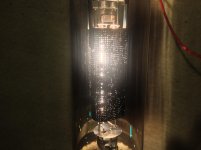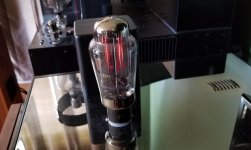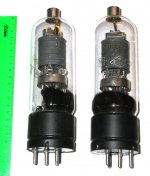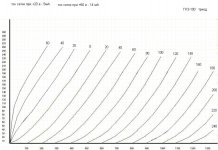The 833A SET is so easy to build once you know how to do it that it is impossible to resist the flamboyance of flouting it in your home. They have charisma!
Reminder:
Without proper care, 833A amplifiers can have Shocking results.
Safety First!
Prevent "The Surviving Spouse Syndrome".
I have an 833A with one half of the filament broken, so the other side of the filament takes 10V at 5 Amps.
I use it at Christmas Time, just the lit filament, no B+.
Without proper care, 833A amplifiers can have Shocking results.
Safety First!
Prevent "The Surviving Spouse Syndrome".
I have an 833A with one half of the filament broken, so the other side of the filament takes 10V at 5 Amps.
I use it at Christmas Time, just the lit filament, no B+.
Last edited:
That is very true of anything that uses the unforgiving 1000 or more Volts. 300 to 400, depending on whether you use cathode resistance and direct coupling of the lower anode adjusting the circuit to the lower grid voltage of a 300B, a 2A3, or a 45 is not likely to be deadly but it will shock. Always cover with insulating collars caps to plates. So folks, read what 6A3sUMMER tells us and keep things safe.
Hello, Magz. Your speakers are also big and 4 Ohms, like mine. So we had to solve common problems. And I believe that you have come to an excellent sound. Also the system looks beautifully.I too wanted to drive big, inefficient speakers (Infinity RSIIb) full-range with an SET, so high-voltage transmitter tubes became the solution. Enjoy!
At 2300V anode and 160mA, I get 40W Class A1 and up to 200W in Class A2. Mostly I stay in A1 but transients definitely push me well into A2. Very powerful, yet definitely SET sound. I went for the Monolith OPTs, expensive but they are great-sounding!
Mine is more modest. I only use 1000 Volts and zero grid bias which draws 120 ma through a transformer rated for 300 ma. Using a poor man's way to measure how linear it is I put flash light batteries between grid and ground, reverse polarity, and the increase in current positive bias measures the same as decrease in current at negative bias. It also sounds gorgeous and is more than loud enough through Magnapans turned about half way up.
If I am right, Wavac amps also operate at 1000 V and zero grid bias. But maybe you also have come to relatively high output resistance, as Wavac. It would not be good with my speakers.
For $350,000 do you even get polypropylene filter capacitors in the high Voltage power supplies? Using the best parts money can buy you pay under $2000 for parts to build an amplifier at least as good as the WAVAC. I don't have the know how to perform the psychological manipulation it takes to get anyone to pay me $348,000 for a week or two of the labor it takes to build that kind of an amplifier and it would not surprise me if most people could build one faster than I can, but getting so conspicuously overpaid would not be honest or fair to any customer so I would not do it even if I could.
I have found interesting info at radio amateurs forum, at the below following post #20, about GU-48 tubes
????????? ?? ??-48 - ???????? 2
"Actually, the attractiveness of the GU-48 tubes arose immediately, as soon as the expensive Wavac SH-833 amplifier was manufactured in Japan. It is noteworthy, that in the Wavac SH-833 there is not the original 833A, but our GU-48 of the "Polyaron" plant, although the Japanese also had the original 833A on tests, and not one.
There are 2 options - 833A with metal anode, and 833C with graphite anode. Actually, our GU-48 is a complete analogue of the 833A. OJSC "Svetlana" is selling to the west the GU-48 of the "Polyaron" plant, simply by repainting them in 833A.
It is the fact that this tube was not originally developed in the USSR. Apparently, it is not widespreaded in audio amplifiers due to the fact, that we have a GU-81M with a lower internal resistance. Analogues of the GU-81M have not been made and are not being made in the USA. Only in Europe were there similar examples - Telefunken RS 384.
I can say with confidence, comparing both tubes live, that our GU-48 was clearly done after studying the errors and shortcomings of the 833A. The disadvantages of 833A are that the anode and grid-cathode block hold independently of each other (cathode and grids - by the filament horns, the anode - by one of the upper pins) and there have been cases when, during the operation of the tube, that relative position of the tube electrodes has been changed with the corresponding "swim" of the I - V characteristic. "
I would add from myself, that now interest to graphite anode GU-81M goes to almost zero, since GU-48 is better soundwise.
????????? ?? ??-48 - ???????? 2
"Actually, the attractiveness of the GU-48 tubes arose immediately, as soon as the expensive Wavac SH-833 amplifier was manufactured in Japan. It is noteworthy, that in the Wavac SH-833 there is not the original 833A, but our GU-48 of the "Polyaron" plant, although the Japanese also had the original 833A on tests, and not one.
There are 2 options - 833A with metal anode, and 833C with graphite anode. Actually, our GU-48 is a complete analogue of the 833A. OJSC "Svetlana" is selling to the west the GU-48 of the "Polyaron" plant, simply by repainting them in 833A.
It is the fact that this tube was not originally developed in the USSR. Apparently, it is not widespreaded in audio amplifiers due to the fact, that we have a GU-81M with a lower internal resistance. Analogues of the GU-81M have not been made and are not being made in the USA. Only in Europe were there similar examples - Telefunken RS 384.
I can say with confidence, comparing both tubes live, that our GU-48 was clearly done after studying the errors and shortcomings of the 833A. The disadvantages of 833A are that the anode and grid-cathode block hold independently of each other (cathode and grids - by the filament horns, the anode - by one of the upper pins) and there have been cases when, during the operation of the tube, that relative position of the tube electrodes has been changed with the corresponding "swim" of the I - V characteristic. "
I would add from myself, that now interest to graphite anode GU-81M goes to almost zero, since GU-48 is better soundwise.
There is very interesting powerful European pentode with metal plate - 5C/450A, but rare 🙁I would add from myself, that now interest to graphite anode GU-81M goes to almost zero.
I use the graphite anode 833A I order from ebay and have had good luck with it. The metal anode ones sometimes have half the cathodes broken causing them to work at half the output but still broken.
I use the graphite anode 833A I order from ebay and have had good luck with it. The metal anode ones sometimes have half the cathodes broken causing them to work at half the output but still broken.
I never heard about such an issue with GU-48 tubes. And, I am sure from my personal experience, metal anode is always better sound wise. Although, mechanical design is also important.
I've heard people say graphite anodes have a 'softer, more rounded, less detailed" sound than metal plates. I can't imagine getting any more detail than what I get now from the 833C. Ultra-detailed is how I would describe it, but without harshness.
To each his own, as they say.
To each his own, as they say.
I've heard people say graphite anodes have a 'softer, more rounded, less detailed" sound than metal plates. I can't imagine getting any more detail than what I get now from the 833C. Ultra-detailed is how I would describe it, but without harshness.
To each his own, as they say.
There is no doubt in your words. The only point, sound details are shown also by many transistor amps. Metal anode refers more to "cleaned" or "purified" sound details.
Graphite anodes, hot anodes, metal, nickel, etc.
I've never see better looks than mesh and holed 🙂
I like mesh rectifier tubes, and run an EML 274B rectifier in my UX-201A preamp/DAC.
Attachments
Small power mesh plate tubes are very nice! There is no comments about. I'm using mesh pentodes as first tube now as well.
Did you see plenty power tubes such design? At least over 100W plate.
Did you see plenty power tubes such design? At least over 100W plate.
Last edited:
Oh, this tube is really good, both technically and visually. And you Roman (Kruzhka) seems to be a happy owner of such tubes, since you sell themThere is very interesting powerful European pentode with metal plate - 5C/450A, but rare 🙁
5C/450A STC 4212E Tube Valve Audio DHT Pentode Triode Blue Print Tested! | eBay
But the price I could not afford. For one such tube I could have 7pcs of good old NOS (1974 with zirconium plated thick metal anode) and even matched GU-48. And who knows, about final sound result, if to compare these tubes. Also a spare pair of tubes is needed, if to invest in such a huge project.
Among old metal anode tetrodes, that were manufactured in Tashkent in years 1950s, I would mention GKE-100 tube. It is still more affordable than metal anode GM-70. Its maximum plate dissipation is 80W, plus 16W dissipated by the second grid if triode connected, so we come to near 100W dissipation power. Triode curves have been measured by one colleage from Ukraine.
I also heated them up, and was surprised by their stable behaviour. After 70 years of storage, anode current came to stable point after few seconds of operation.
I also heated them up, and was surprised by their stable behaviour. After 70 years of storage, anode current came to stable point after few seconds of operation.
Attachments
Last edited:
GKE-100 looks great as output tube candidate. This tube is not popular and still available for peanuts. I had few of these also.
Crazy decisionOh, this tube is really good, both technically and visually.
 [電子工作] 砲弾サイズ真空管5C/450Aの動作確認|digiponta|note
[電子工作] 砲弾サイズ真空管5C/450Aの動作確認|digiponta|note- Home
- Amplifiers
- Tubes / Valves
- Tube amplifiers with PMC EB1i speakers



